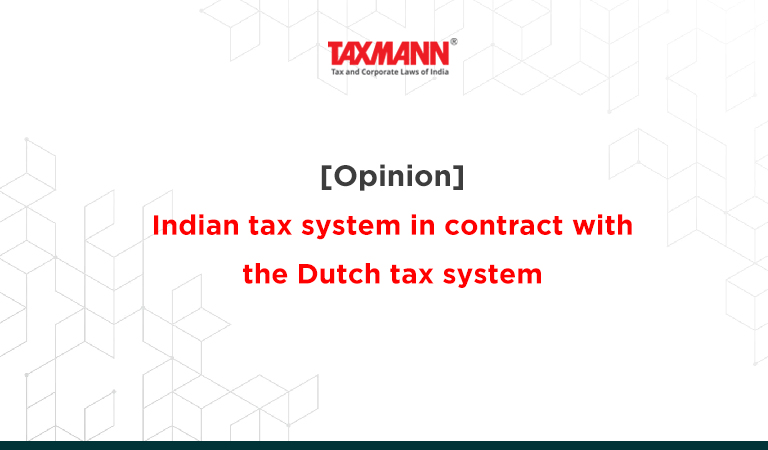[Opinion] Indian tax system in contract with the Dutch tax system
- Blog|News|International Tax|
- 3 Min Read
- By Taxmann
- |
- Last Updated on 27 January, 2023

Rishabh Agarwal – [2023] 146 taxmann.com 362 (Article)
1. Introduction
This paper is a comparative analysis of the Indian tax system and the tax system in the Netherlands (the Dutch tax system) on the following aspects:
- Advance tax rulings
- Limitation on interest deduction
- Withholding tax on royalty and interest
- Definition of Permanent Establishment (PE) v. Business connection
2. Ruling policy
India
Under the ruling scheme, the power of giving advance rulings has been entrusted to an independent body, which is headed by a retired judge of the Supreme Court. This body is empowered to issue rulings, which are binding both on the tax authority and the applicant. The procedure prescribed is simple, inexpensive, expeditious and authoritative. Advance Ruling (AR) means a written opinion or authoritative decision by an Authority empowered to render it concerning the tax consequences of a transaction or proposed transaction or an assessment in regard thereto. Only a non-resident, a resident-undertaking proposing to undertake a transaction with a non-resident in respect of any question of law or fact concerning the tax liability of the non-resident, a resident who has undertaken or proposes to undertake one or more transactions of the value of at least Rs.100 crore, a notified public sector company, any person, being a resident or non-resident to decide whether an arrangement proposed to be undertaken by him is subjected to GAAR or not are authorized to obtain an AR.
There is a limitation to the areas for which the AR can be obtained. If the question concerned is pending before other authorities or if the question concerns the determination of FMV of a property or related to the transaction which is prima facie for the avoidance of income tax then such an AR cannot be obtained.
Netherlands
It has an open system of advance tax rulings (ATR) which enables companies and individuals to approach the tax authority and seek guidance in advance on the fiscal implications of their transactions. Also, the policy covers a wide area of tax law that can be taken up for the rulings. Generally, an ATR is treated as a binding advance opinion from the tax authority based on the provided facts and circumstances. It is binding only concerning the activities specified by the ruling. If the facts and circumstances change then the ruling is void and cancelled. The tax administration does not issue a ruling if the proposed structure or transaction is in conflict with domestic or international tax law or erodes the tax base in the Netherlands (Anti-abuse provision).
3. Limitation on interest deduction
India
Under this anti-base erosion provision when an Indian company, or a permanent establishment of a foreign company in India, being the borrower, incurs any expenditure by way of interest which exceeds Rs. 1 Crore which is deductible from the income of business or profession and such money has been borrowed from an associated enterprise (AE) then the maximum interest allowed to be deducted shall not exceed the 30% of earnings before interest, taxes, depreciation and amortization (EBITDA). Any disallowed interest is allowed to be carried forward for a period of 8 assessment years.
Also, if the debt has not been directly issued by the AE but an AE either provides an implicit or explicit guarantee to such lender or deposits a corresponding and matching amount of funds with the lender, such debt shall be deemed to have been issued by an AE. Further, these provisions do not apply to banking and insurance businesses.
Netherlands
With effect from 1 January 2019, the new interest deduction limitation rule has been implemented according to the Anti-Tax Avoidance Directive (ATAD) whereby the net interest deduction is restricted to 30% of the earnings before interest, taxes, depreciation and amortization (EBITDA) as determined under the fiscal accounts However, a safe harbour rule applies under which the first EUR 1 million of interest expenses is deductible. The term net interest expenses is defined as the difference between the amount of interest paid and the amount of interest received.
Excess interest expenses that may not be deducted in the relevant tax period may be carried forward without time limitation.
Click Here To Read The Full Article
Disclaimer: The content/information published on the website is only for general information of the user and shall not be construed as legal advice. While the Taxmann has exercised reasonable efforts to ensure the veracity of information/content published, Taxmann shall be under no liability in any manner whatsoever for incorrect information, if any.

Taxmann Publications has a dedicated in-house Research & Editorial Team. This team consists of a team of Chartered Accountants, Company Secretaries, and Lawyers. This team works under the guidance and supervision of editor-in-chief Mr Rakesh Bhargava.
The Research and Editorial Team is responsible for developing reliable and accurate content for the readers. The team follows the six-sigma approach to achieve the benchmark of zero error in its publications and research platforms. The team ensures that the following publication guidelines are thoroughly followed while developing the content:
- The statutory material is obtained only from the authorized and reliable sources
- All the latest developments in the judicial and legislative fields are covered
- Prepare the analytical write-ups on current, controversial, and important issues to help the readers to understand the concept and its implications
- Every content published by Taxmann is complete, accurate and lucid
- All evidence-based statements are supported with proper reference to Section, Circular No., Notification No. or citations
- The golden rules of grammar, style and consistency are thoroughly followed
- Font and size that’s easy to read and remain consistent across all imprint and digital publications are applied



 CA | CS | CMA
CA | CS | CMA
